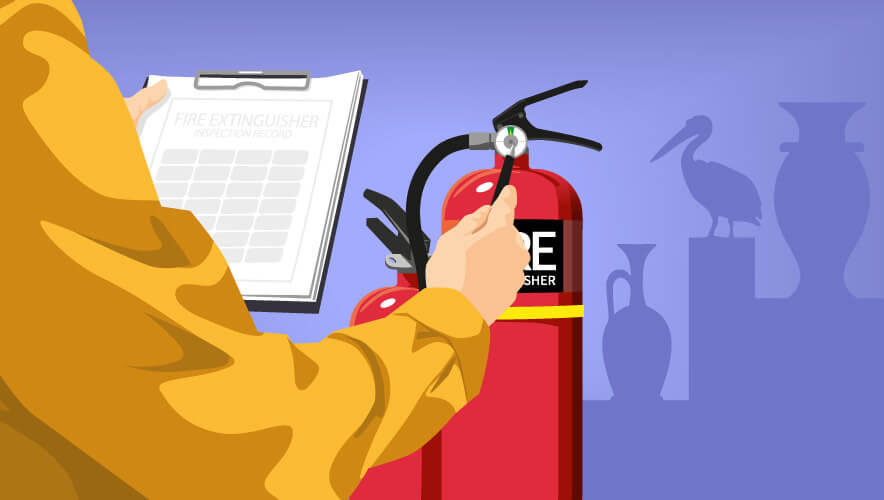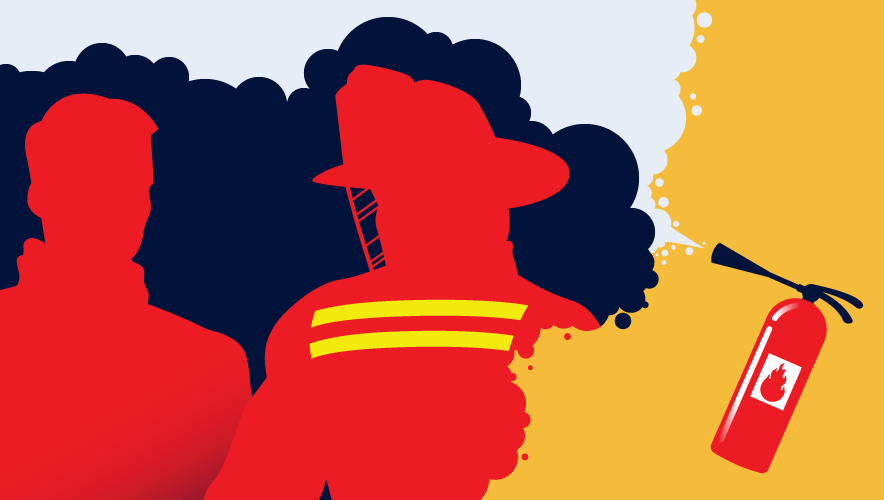Building a Partnership for Protection: The Smithsonian and DC Fire
It started with an honest mistake. A contracted cleaner at the National Zoo and Conservation Biology Institute in Washington, D.C., accidentally mixed the wrong chemicals together, causing a reaction that led to a call to the local fire department.
“It was reported as an explosion at the National Zoo, which obviously elicits a pretty large response,” recalls Eric Gentry, director of emergency management at the Smithsonian Institution, of the incident that occurred in 2017.
No people or animals were injured in the accidental chemical reaction. But the incident was fortuitous because it brought together then Battalion Fire Chief John A. Donnelly, Sr., and Gentry. At the zoo, they started talking about the need to do some familiarization tours so in the event of a serious incident, firefighters would be better prepared to respond.
That conversation led to a partnership that continues to build relationships between the institute and the department today.
“It’s been a process for a number of years now, but more importantly, it started off from a chance meeting at an actual event,” Gentry says.
Laying the Foundation
British scientist James Smithson died in 1829. Despite never travelling to the United States, he made contingencies in his will that ultimately bequeathed his estate to the United States of America to found an institution in Washington, D.C., to “increase and share knowledge among men.”
Smithson’s gift created the Smithsonian Institute, which is now responsible for 21 museums, the National Zoo, and multiple research centers. These facilities cover 13.8 million square feet of building space, where a staff of 6,500 full-time employees act as caretakers for more than 155 million objects and specimens that are viewed by roughly 26 million people each year.
Part of the full-time staff includes the employees of the Office of Emergency Management (OEM), which Gentry joined to oversee after working as a local and state emergency service director with the U.S. Department of Homeland Security’s Federal Emergency Management Agency (FEMA).
“I understood before I got to the Smithsonian how important partnerships and relationships with other agencies are,” Gentry says.
At the Smithsonian, he’s worked to maintain internal partnerships with the Smithsonian’s Security; Planning and Design; and Safety, Health, and Environmental Management Offices to mitigate risks and respond to threats that the Smithsonian faces.
“At a large organization like the Smithsonian, it’s very easy to develop stovepipes,” Gentry explains. “It’s fundamental in emergency management to make sure that we are pan-institutional, and we work as hard as we can to not support stovepipes and to coordinate throughout the Smithsonian internally and then also with our external partners.”
One of those external partners is the Washington, D.C., Fire and EMS Department, which is the agency that responds to calls for fire suppression and rescue activities, as well as some medical emergencies, within the capital city. The department has 33 engine companies, 22 basic life support ambulances, 17 medic units (ambulances staffed by paramedics), and 16 ladder trucks, as well as specialized rescue squads, a hazardous materials unit, and a fireboat unit.
Mitchell Kannry, fire marshal and deputy fire chief of fire prevention, has been with the DC department for roughly 19 years. While U.S. federal government buildings—including the Smithsonian—are not subject to DC fire codes, the DC fire department is still responsible for responding to calls at these facilities. Those emergencies come with their own, unique risk factors.
“We have the Smithsonian, the White House, the U.S. Capitol,” Kannry explains. “Museums in particular pose challenges because of occupancy—the people there on the National Mall—especially in the spring and summer time.”
When it comes to the Smithsonian, Kannry says some of the challenges for fire response include the vast collections of rare items, volatile and hazardous materials, and restricted access points for department personnel to respond to an emergency. So, when the opportunity presented itself in 2017 to have a more formal partnership to increase firefighters’ familiarization with the Smithsonian’s assets, the two teams seized it.
Constructing the Frame
After the incident at the National Zoo, Gentry’s team worked with Donnelly to arrange familiarization tours for DC firefighters to visit the Smithsonian buildings starting with the National Museum of African American History and Culture.
They discussed what would be important for fire personnel to cover in a tour and who from the Smithsonian team should be on hand to participate. This would include facilities and maintenance employees, as well as the individuals who support, maintain, and research the animals and objects that are part of the Smithsonian’s collection.
Many of these individuals are experts in their field and have worked at the Smithsonian for years, so they can provide important insight to firefighters about what is in the collection, how it is preserved, and what might make it dangerous during an incident response.
“At the zoo, there is no single animal keeper that can then talk to all the different aspects of the park. The people that work in lions and tigers, or great apes or with the elephants, those are all different programs,” Gentry explains. “We have to get commitments from the various groups at the museums and the zoo to support these walkthroughs—to be there to lead as we get to their portion of the tour.”
Maintenance and facility staff would need to be available to share information on where electrical gear, switching gear, HVAC systems, generators, fuel tanks, and fire department connections are.
Security staff would also need to be on hand to provide access to secure areas of the Smithsonian—like collections storage and research areas—and to review how they would handle opening those areas should the fire department need to respond to an incident. These team members can also provide information on where the fire department can stage ladder trucks to gain roof access while avoiding bollards and many other security design features meant to keep vehicles away from the Smithsonian’s facilities, Gentry adds.
Finally, the Smithsonian’s Office of Safety, Health, and Environmental Management would also need to participate to track the tours and respond to requests for additions to the tour or follow-up information for both fire and Smithsonian personnel.
It's fundamental in emergency management to make sure that we are pan-institutional.
Once the material to cover and the stakeholders needed to participate were identified, Gentry then did a practice run with Donnelly to highlight any gaps in the planning. They then scheduled to have a fire company come to the museum on a Friday morning to do the tour with the Smithsonian team.
That initial tour kicked off a project to attempt to have each fire company do a site visit at the museum on a Friday morning—a process that took eight weeks. It has since continued, now led by Gentry and Kannry with the support of Fire Chief Donnelly.
The information in the familiarization tours has helped the fire department put together maps of Smithsonian facilities that show their 24-hour access points, sprinkler connections, and alarm locations. Companies can easily reference these maps if they are responding to a call—especially if the facility is closed for the day.
“It might be 2 a.m. when you get a call. You can’t just walk up to the front door of the Air and Space Museum and get in,” Kannry says.
Reinforcing the Support Beams
An important aspect of the partners
hip program is building fire personnel’s understanding of what’s in the Smithsonian collection and measures that need to be taken to preserve it during an incident.
“Some of these collections are rare or valuable—like the diamonds in the Natural History Museum—so it’s important to make sure the firefighters understand the importance of preservation. That what we’re doing will have the least amount of impact to mitigate that incident,” Kannry adds.
During familiarization tours, the Smithsonian team discusses the types of fire suppression systems in place that are unique to museum settings. In a typical office space, dry-powder ABC class fire extinguishers are often used because the priority is to control the fire—to keep it as small as possible and put it out as fast as possible. Museums have that same priority, but they also need to consider what extinguishing measure will have the least long-term impact on the collection, Gentry says
“In many cases, for example, instead of having a standard dry powder chemical fire extinguisher readily at hand, ours may be a water mist extinguisher, which is a little more uncommon these days,” he explains. “Depending on what is in the collection, it may handle water mist much better or tolerate water mist and be much easier to clean up the item—recover in the aftermath—than it would after having the chemical dry powder put all over the collection.”
Smithsonian teams also must consider how collections are stored or treated, and how that impacts extinguishing methods and firefighter response.
“Almost all Smithsonian facilities contain lab research areas with chemicals,” Kannry says. “There’s a lot of chemical storage in areas that are not easily accessible—basements and attics—so understanding what’s there, how to get to those areas, and what those chemicals can do if they’re exposed to fire is important.”
For instance, many specimens in the Smithsonian’s collection are stored in alcohol (which is extremely flammable), and some items have been preserved with arsenic (which is toxic to humans). Understanding these risk factors helps keep firefighters safe when responding to an incident and also helps them react in a way that could better preserve the Smithsonian’s collection. For instance, knowing where hazards and collection items are may change the way firefighters use water to extinguish a fire.
We have a vested interest in making it easier for the fire department because that supports our efforts if we ever have an emergency.
Additionally, Gentry says in the familiarization tours that they talk about preserving the records that Smithsonian staff have put together that provide context for what the collection is.
“One of the biggest things is teaching the fire department the importance of keeping the library on the collection intact—that can be just as important as the collection itself,” Gentry explains. “Without the information that describes, that gives the history, background, and collection location…losing that can be as damaging as losing parts of the collection.”
Since the partnership began, the Smithsonian has done more than 57 familiarization tours with the fire department—including additional walk throughs ahead of planned renovations and restorations when facilities are at increased risk for fire. For instance, the partners recently did a series of tours of the National Air and Space Museum because it is in the midst of a major renovation project.
“We actually do walkthroughs of the construction sites to show the fire department that things change, things move,” Gentry adds. “You still have to have fire protection within the building, but those connection locations at some point during the renovation may have to be relocated. The fire department has to know that.”
Preparing for Preventative Maintenance
As the familiarization tours have continued, fire personnel have asked for additional information or pointed out unique building features that the Smithsonian team then logs to ensure they are covered in future tours.
“It also helps us as we plan for new collections, new buildings, and new renovations,” Gentry says. “It’s worked well all the way around. We have a vested interest in making it easier for the fire department because that supports our efforts if we ever have an emergency.”
Gentry has also worked with internal stakeholders to educate Smithsonian personnel about best practices for communicating with fire department representatives and responding to an incident. For example, informing staff what the A side of a building is (the address or street side) and where firefighters would enter the building.
“To know which door they’re going to show up to—something as simple as that can save precious minutes,” Gentry adds.
Smithsonian employees have also learned that when an incident occurs, they should designate a liaison who can communicate with the incident commander and fire department personnel. For instance, designating a staff member to talk to the incident commander about risk factors, like avoiding eye contact with animals, when responding to an incident in the Great Cats area of the National Zoo.
Along with the familiarization tours, the Smithsonian and fire department worked together to create a training video that is now part of onboarding for all fire personnel and available in their online training platform. This ensures that even if the fire company hasn’t done a familiarization tour at a particular Smithsonian facility, firefighters still have some basic knowledge of the characteristics and risk factors involved to responding to an incident.
“The Smithsonian really took the initiative, with the video that our members can access on their online system,” Kannry says. “It was a big undertaking by the Smithsonian, but it was a huge benefit.”
And the benefits in building relationships through the partnership have already begun to pay off. Just weeks after conducing the first familiarization tour at the National Museum of African American History and Culture, a fire broke out in a loading dock at the museum.
The fire company that responded to the call had not been through the museum on a familiarization tour yet, but because he already knew Kannry, Gentry was able to reach out to him to connect with the battalion chief on site to immediately address any concerns.
“I was talking with the incident commander via telephone from my house as soon as the alarm came in because of this relationship,” Gentry adds. “Even though I had not worked with the battalion chief on the walkthroughs and his crews had not been through the building, the relationship built still paid off.”
Megan Gates is editor-in-chief of Security Technology. Connect with her at [email protected] or on LinkedIn. Follow her on Twitter: @mgngates.












